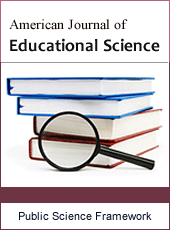American Journal of Educational Science
Articles Information
American Journal of Educational Science, Vol.1, No.2, May 2015, Pub. Date: May 14, 2015
Gender Representation in English Language Textbooks: Action Pack 10
Pages: 14-18 Views: 5829 Downloads: 2865
[01]
Mohammed Y. Nofal, Department of Education, United Nations Relief and Works Agency, Amman, Jordan.
[02]
Hanadi A. Qawar, Department of English, Faculty of Arts and Sciences, Middle East University, Amman, Jordan.
The purpose of this study is to examine gender representation in one of the English language textbooks in Jordan, namely, Action Pack 10. Three questions are posed concerning the ratio of female to male characters and the depiction of female and male characters in social and settings in domestic settings as well. A content analysis is carried out, including linguistic and visual analyses. The results have revealed that male characters are over-presented linguistically, visually and socially. The ratio of females to males in texts and illustrations is 1:3 and males monopolize more social roles than females. In conclusion, Action Pack 10 has failed to mirror the modern Jordanian society where the Jordanian woman enjoys excellent positions and is highly admired.
Gender Bias, Representation, EFL Textbook, Jordan, Action Pack 10
[01]
Cohen, L. & L. Manion. (1992). Research method in education (3rd ed.): London: Rutledge.
[02]
Gharbavi, A. & Mousavi, A. (2012). A Content Analysis of Textbooks: Investigating Gender Bias as a Social Prominence in Iranian High School English Textbooks. English Linguistics Research. 1(1), 42-49.
[03]
Hall, M. (2014). Gender Representation in Current EFL Textbooks in Iranian Secondary Schools. Journal of Language Teaching and Research. 5 (2), 253-261.
[04]
Hamdan, S. & Jalabneh, A. (2009). Topics in EFL textbooks and the question of gender dominance: A case study from public schools of Jordan. The International Journal of Language Society and Culture. 28, 52-56.
[05]
Hamdan, S. (2010). English-language Textbooks Reflect Gender Bias: A Case Study in Jordan. Advances in Gender and Education, 2, 22-26.
[06]
Law, K, & Chan, A. (2004). Gender role stereotyping in Hong Kong’s primary school Chinese language subject textbooks. Asian Journal of Women’s Studies, 10, 49–69.
[07]
Lee, J. and Collins, P. (2008). Gender Voices in Hong Kong English Textbooks—Some Past and Current Practices. Sex Roles. 59, 127–137.
[08]
Nagatomo, D. (2010). A Critical Analysis of Gender Representation in an EFL Textbook. Journal of the Ochanomizu University English Society, 1, 53-61.
[09]
Porreca, K. (1984). Sexism in Current ESL Textbooks’. TESOL Quarterly 18:705-24.
[10]
Sadker, D. and Sadker M. (2001). Gender bias from colonial America to today's classrooms. In J. Banks (Ed). Multicultural education: Issues and perspectives (4th ed.) (pp. 135-169) New York: John Wiley.
[11]
Shteiwi, M. (2003). Gender Role Stereotypes in Primary School Textbooks in Jordan. DIRASAT, Social and Human Sciences, 30, 90-104.
[12]
Turner-Bowker, D. (1996). Gender stereotyped descriptors in children’s picture books: Does “Curious Jane” exist in the literature? Sex Roles, 35(7/8), 461-488.

ISSN Print: 2381-7127
ISSN Online: 2381-7135
Current Issue:
Vol. 6, Issue 2, June Submit a Manuscript Join Editorial Board Join Reviewer Team
ISSN Online: 2381-7135
Current Issue:
Vol. 6, Issue 2, June Submit a Manuscript Join Editorial Board Join Reviewer Team
| About This Journal |
| All Issues |
| Open Access |
| Indexing |
| Payment Information |
| Author Guidelines |
| Review Process |
| Publication Ethics |
| Editorial Board |
| Peer Reviewers |


